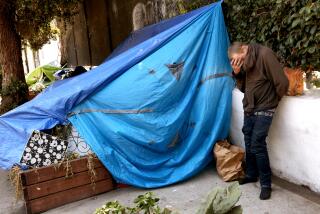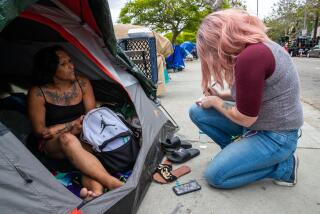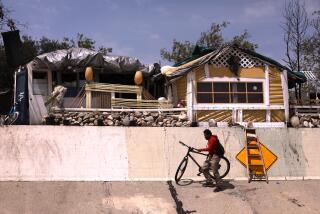Shelter openings and groundbreakings mark progress in L.A.’s homelessness response
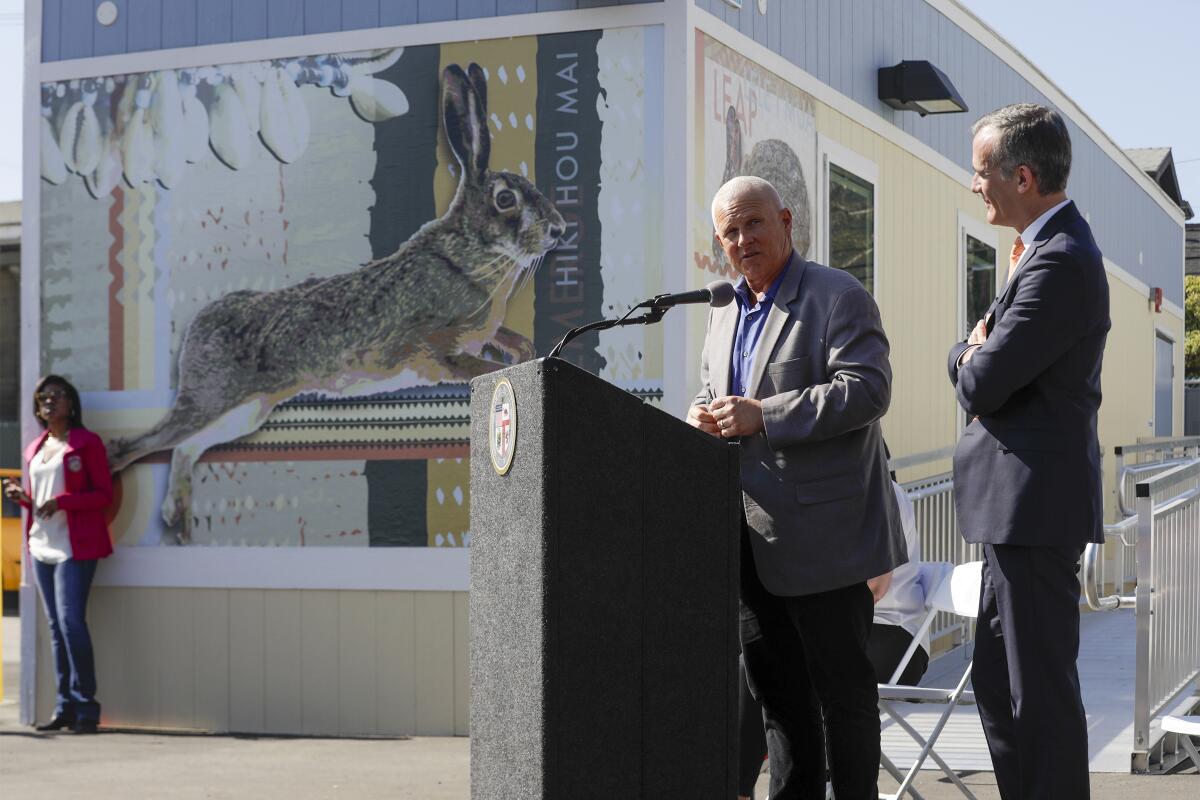
At a town hall 16 months ago, Los Angeles Mayor Eric Garcetti and City Councilman Mike Bonin endured a public flogging from residents who were incensed by a plan to build a homeless shelter across the street from some of the priciest real estate in Venice.
The opposition continued, first with a scathing social media campaign and then with a lawsuit.
But all that was only a bittersweet memory last week, when Garcetti and Bonin stood before an appreciative crowd of homeless advocates and service providers to open Pacific Sunset, a 154-bed bridge home shelter for men, women and young adults. It was built — rapidly — across from that pricey real estate on the site of a vacant Metropolitan Transit Authority storage yard.
“We will never let opposition stop us from the greatest fight of our lives,” Garcetti said Tuesday, recalling the night he described as “the most traumatic public meeting I’ve ever done.”
The opening of the Venice shelter was the emotional highlight of several events over the last two weeks, demonstrating that momentum is finally building to address street homelessness in the city and county of Los Angeles.
On Feb. 20, Garcetti had appeared with Councilman Paul Krekorian under Department of Power and Water utility lines in North Hollywood to celebrate the completion of the city’s first so-called navigation center, where homeless people can store their possessions in 120 bins, use the showers and toilets and connect with case managers.
On Feb. 24, Gov. Gavin Newsom visited families who were moving into temporary homes in 10 state emergency trailers that, on his order, were donated to the county, trucked to South Los Angeles and installed on a former city parking lot.
Then on Wednesday, the day after the Venice facility opened, Garcetti joined Councilman David Ryu for the groundbreaking on what will be a 100-bed shelter on Riverside Drive in Los Feliz.
That shelter, scheduled to open in early summer, will be one of four in Ryu’s district and among the 25 shelters that Garcetti has promised will be open by July, providing 2,000 emergency shelter beds under his A Bridge Home program. Ten of those shelters are currently open with 673 beds.
And on Friday, the skid row nonprofit Union Rescue Mission held a groundbreaking for a 374-bed shelter it is building with private financing in South Los Angeles. Angeles House, scheduled for completion next year, will be a three-story building providing private quarters with kitchens and bathrooms to 86 families, said Andy Bales, the mission’s president and chief executive.
Los Angeles County opened a new 40-bed shelter in San Pedro on Monday. The $300,000 renovation of a former county health clinic on West 8th Street was completed in six weeks, Supervisor Janice Hahn’s office said. It will be run by Harbor Interfaith Council.
Plans for the Venice shelter triggered a lawsuit by an advocacy group, the Venice Stakeholders Assn., arguing that the city and other government agencies had failed to properly review how “this large and extraordinary project” would affect the neighborhood.
A Superior Court judge ruled against the group, citing a state law, championed by Assemblyman Miguel Santiago (D-Los Angeles), that exempts any shelter or homeless housing project in Los Angeles from the California Environmental Quality Act if it receives funding from key state and local sources.
At the opening last week, Garcetti and Bonin were met by an appreciative crowd, affirming that the resistance they faced was a minority of Venice residents.
“If the price of making sure that the kids of Venice don’t need to walk in the middle of the street to get to school because the sidewalks are filled with encampments is a string of profanities on my social media accounts, that’s the price we will pay because the alternative is just absolutely unthinkable,” Bonin said.
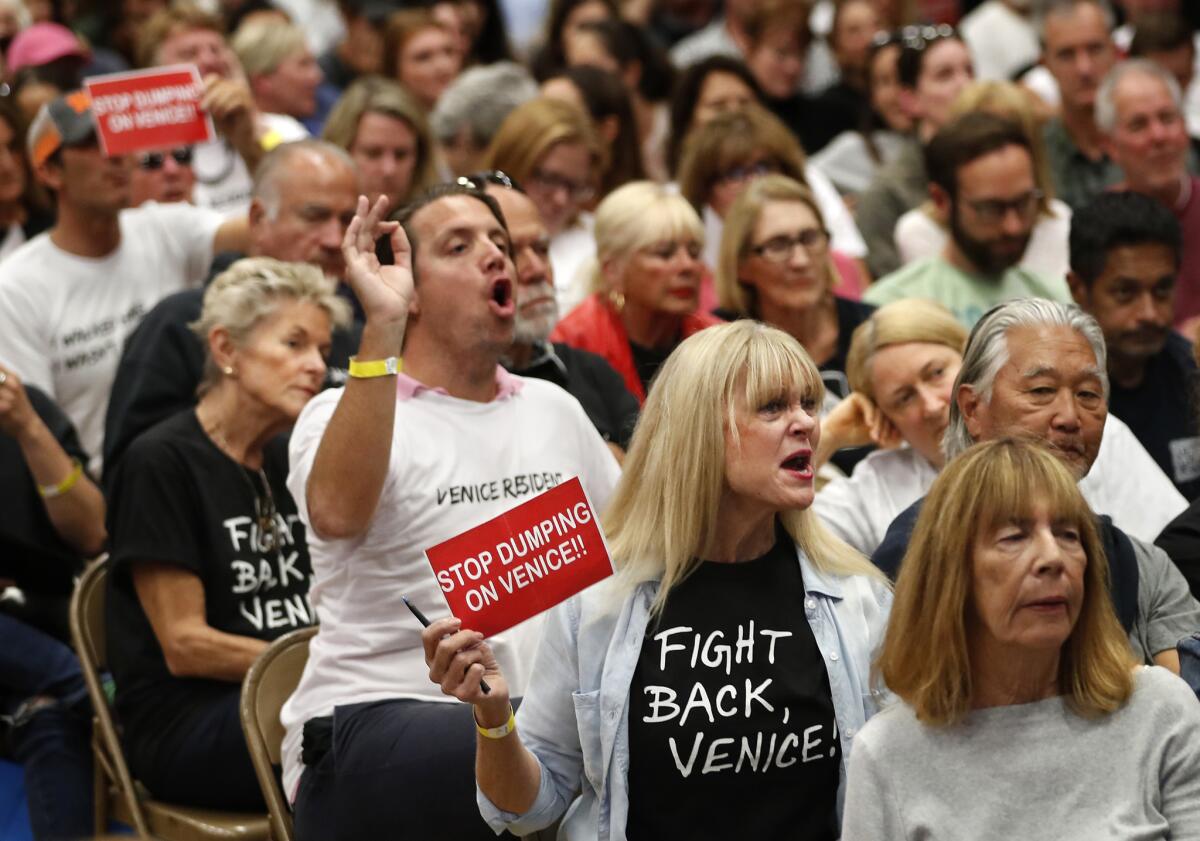
Pointing out wildlife murals painted on the shelter buildings by local artists, Bonin said the project was “by and of” Venice, not just for Venice.
The 3.15-acre campus will include an outdoor covered eating area and an area for pets. The main building, a steel-frame, plastic-skinned temporary structure, is divided into two bays with cubicles and cots for 66 men and 34 women. The 54 youth beds are distributed over five modular buildings. Additional modular buildings hold showers and bathrooms and offices for staff.
Meals will be served from a food truck.
The $8.5-million Venice shelter received funding from the city, the state and private donors, including an anonymous $3-million donation. Los Angeles County will pay for operations. The nonprofit group People Assisting the Homeless will run the shelter and provide services for adults. Venice-based Safe Place for Youth will serve the young adults, ages 18 to 24.
As soon as the crowd dispersed last week, People Assisting the Homeless began admitting clients who had been preselected by outreach workers from Safe Place for Youth and the Venice-based St. Joseph Center. By Thursday, 58 adults and 26 youths had checked in.
The navigation center in North Hollywood is a more modest facility, with a row of showers and toilets, a large modular building filled with 120 trash-can-style storage bins and a smaller building for staff. After it opens on Thursday, it will be a daytime drop-in center only.
During the ceremony marking its completion, site director Laurie Craft of the homeless services organization Hope for the Valley acknowledged that such centers have been criticized as band-aids rather than a solution.
“Band-aids facilitate and promote healing,” Craft said. “They prevent things from getting worse. ... Navigation centers are entry points into the system. They are places for people to begin, to prevent an individual’s housing crisis from getting worse.”
By summer, it will become an access point for two East Valley shelters now under construction.
A push by the city, the county and the St. Joseph Center, and an outpouring of volunteer labor, transformed a city parking lot into SOLA Open Air, the new South L.A. trailer home, in only three weeks.
It began with a call from County Supervisor Mark Ridley-Thomas to Va Lecia Adams Kellam, St. Joseph’s president and chief executive, asking if she would be interested in running a pop-up shelter in the parking lot on the same block as the agency’s South Los Angeles satellite near 85th Street and Broadway.
“I knew this could happen,” Adams Kellam said. “I was so ready for the call.”
Leases were executed, permits were obtained, utilities were installed and welcome kits were prepared, all for an estimated $300,000, plus several thousand dollars in donations.
As of last week, nine families had moved in and the 10th was on the way. All had been living on the street, in cars or in vans when St. Joseph outreach workers told them homes were waiting.
“You never hear of anything happening that quickly,” Adams Kellam said.
Twenty more state-owned trailers are coming to Los Angeles. The second batch was delivered Thursday to a former L.A. County Probation Department building at Crenshaw and Exposition boulevards.
The remaining 10 will go to a location yet to be chosen in Hahn’s district.
More to Read
Sign up for Essential California
The most important California stories and recommendations in your inbox every morning.
You may occasionally receive promotional content from the Los Angeles Times.
